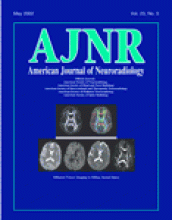Abstract
BACKGROUND AND PURPOSE: Intracranial aneurysms are common, with an overall frequency ranging from 0.8% to 10%. Because prognosis after subarachnoid hemorrhage is still very poor, treatment of unruptured aneurysms, either neurosurgically or endovascularly, has been advocated. However, risk of rupture and subsequent subarachnoid hemorrhage needs to be considered against the risks of elective treatment. We analyzed the technical feasibility, safety, and efficacy of endovascular treatment of a consecutive series of unruptured cerebral aneurysms.
METHODS: From July 1997 through December 2000, a total of 76 patients with 82 unruptured cerebral aneurysms were treated at our institution. Endovascular treatment was administered to 39 consecutive patients with a total of 42 unruptured cerebral aneurysms. Thirty-six aneurysms were treated with an endosaccular technique; in six patients, the parent artery was occluded to eliminate aneurysmal perfusion. Aneurysms were located either in the anterior (n = 31) or posterior (n = 11) circulation. Eight patients had experienced previous subarachnoid hemorrhage from other aneurysms and were treated electively after complete rehabilitation. Ten patients had neurologic symptoms; in 21 patients, the aneurysm was an incidental finding. Eighteen aneurysms were small (0–5 mm), 11 were medium (6–10 mm), nine were large (11–25 mm), and four were giant (> 25 mm). Occlusion rate was categorized as complete (100%), subtotal (95–99%), and incomplete (< 95%) obliteration.
RESULTS: Endovascular treatment was technically feasible for 38 of 42 aneurysms. Complete (100%) or nearly complete (95–99%) occlusion was achieved in 34 of 38 aneurysms. In four aneurysms of the internal carotid artery, only incomplete (< 95%) occlusion was achieved. All patients except one with mild neurologic deficits according to the Glasgow Outcome Scale and one with mild memory dysfunction but no focal neurologic deficit achieved good recovery, resulting in a morbidity rate of 4.8% and a mortality rate of 0%.
CONCLUSION: Endovascular embolization of unruptured cerebral aneurysms is an effective therapeutic alternative to neurosurgical clipping and is associated with low morbidity and mortality rates. For the management of unruptured aneurysms, endovascular treatment should be considered.
- Copyright © American Society of Neuroradiology












